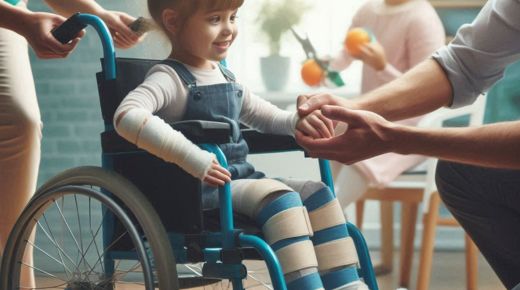
Cerebral palsy (CP) is a neurological condition that affects movement, posture, and coordination due to abnormal brain development or damage. Individuals with CP often face unique challenges that can hinder their ability to perform everyday activities. However, with the right rehabilitation strategies, individuals with cerebral palsy can achieve greater independence and improve their overall quality of life. This article outlines key steps in CP rehabilitation that pave the way toward enhanced independence.
Understanding Cerebral Palsy
Cerebral palsy is a lifelong condition characterized by a range of motor and developmental impairments. The severity of CP can vary widely, with some individuals experiencing mild challenges while others may have significant disabilities. Common symptoms include:
- Muscle stiffness or weakness: This can lead to difficulty with movement and coordination.
- Impaired balance and posture: Many individuals with CP struggle to maintain balance, which affects mobility and stability.
- Difficulty with fine motor skills: Tasks that require precise hand movements, such as writing or buttoning a shirt, can be particularly challenging.
While CP presents distinct challenges, it is essential to recognize that each individual is unique, and their rehabilitation plan should be tailored to meet their specific needs.
The Importance of CP Rehabilitation
Rehabilitation for cerebral palsy is crucial for enhancing functional abilities, promoting independence, and improving overall quality of life. An effective rehabilitation program typically involves a multidisciplinary approach, integrating various therapies and support services to address the diverse needs of individuals with CP. Here are the key components of a successful CP rehabilitation strategy:
1. Comprehensive Assessment
The first step in any rehabilitation program is a comprehensive assessment by a team of healthcare professionals. This may include pediatricians, physiotherapists, occupational therapists, speech therapists, and other specialists.
The assessment evaluates the individual’s physical abilities, mobility, communication skills, and overall development. Understanding the specific challenges faced by the individual allows the rehabilitation team to create a personalized care plan tailored to their unique needs and goals.
2. Physical Therapy
Physical therapy is a cornerstone of CP rehabilitation, focusing on improving mobility, strength, and coordination. A physiotherapist designs a tailored exercise program that targets muscle strengthening, balance, and functional movements.
Therapeutic exercises may include:
- Stretching: To improve flexibility and reduce muscle tightness.
- Strengthening exercises: To build muscle strength and enhance overall stability.
- Gait training: To improve walking abilities, often using assistive devices if necessary.
Through consistent physical therapy, individuals with CP can enhance their motor skills and achieve greater independence in mobility.
3. Occupational Therapy
Occupational therapy is essential for helping individuals with CP develop the skills necessary for daily living activities. Occupational therapists work with patients to improve their ability to perform tasks such as dressing, grooming, and feeding.
Key interventions may include:
- Adaptive techniques: Teaching individuals how to modify tasks to make them easier to perform.
- Assistive devices: Recommending tools such as special utensils, dressing aids, or adaptive equipment to facilitate independence in daily activities.
Occupational therapy focuses on promoting functional independence and enhancing the individual’s ability to engage in meaningful activities.
4. Speech and Language Therapy
Many individuals with CP experience communication difficulties due to motor impairments affecting speech. Speech and language therapy plays a crucial role in helping individuals improve their communication skills, whether through verbal speech or alternative methods.
Therapists may work on:
- Articulation: Enhancing speech clarity and pronunciation.
- Language skills: Improving understanding and use of language.
- Alternative communication methods: Introducing tools such as communication boards or speech-generating devices for individuals with significant speech challenges.
Effective communication is vital for fostering independence and facilitating social interactions, making speech therapy an essential component of rehabilitation.
5. Social Skills and Psychological Support
Rehabilitation for cerebral palsy should also address social skills and emotional well-being. Individuals with CP may face challenges related to self-esteem, social interactions, and anxiety.
Support from psychologists or counselors can provide emotional support and help individuals develop coping strategies. Group therapy sessions can also offer opportunities for social interaction and support from peers facing similar challenges.
6. Family Involvement and Education
Involving family members in the rehabilitation process is crucial for promoting independence in individuals with CP. Families play a vital role in providing support, encouragement, and assistance in implementing therapy strategies at home.
Educating families about cerebral palsy, its implications, and effective care strategies empowers them to be active participants in their loved one’s rehabilitation. Resources such as support groups, workshops, and online forums can provide valuable information and community support.
Rehabilitation for cerebral palsy is a multifaceted process that aims to enhance independence and improve the quality of life for individuals affected by this condition. By utilizing a comprehensive approach that includes physical therapy, occupational therapy, speech therapy, and emotional support, individuals with CP can achieve greater autonomy in their daily lives.
Each step in the rehabilitation process contributes to building confidence and skills, allowing individuals with cerebral palsy to navigate their world with greater independence. With the right support, resources, and commitment, the journey toward improved independence is not only achievable but also transformative for those living with cerebral palsy.
It is very important to do the necessary tests during pregnancy to avoid as many future problems as possible. Your obstetrician-gynecologist will advise you on what is needed according to your needs.
